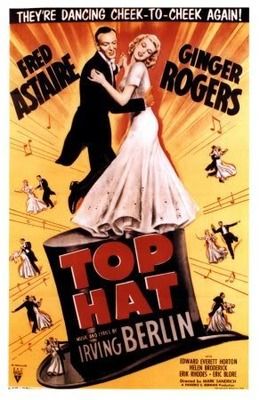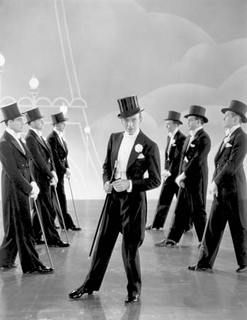
Top Hat
Director: Mark Sandrich
Starring: Fred Astaire, Ginger Rogers, Edward Everett Hooper, Eric Blore, Helen Broderick
1935
When it comes to the classic Fred and Ginger musicals, they range from good to sublime. They all share similar ingredients, but out of all of them Top Hat makes the most out of the raw materials to produce the most scrumptious soufflé of a film.
The plot, such as it is, centers around a case of mistaken identity. Jerry Travers (Astaire) meets Dale Tremont (Rogers) and they fall for each other. Things get complicated, however, when Miss Tremont is lead to believe that Jerry is actually Horace Hardwick (Hooper), who is married to one of her dearest friends (Broderick). Thinking that her friend’s husband has been hitting on her all this time, she is disgruntled and upset, and therein lies the conflict that is, of course, ultimately resolved.
One does not watch a Fred and Ginger movie for the plot. It is typically the least interesting thing about the film. Instead, it’s everything else you could think of that makes it worth watching. The music, the set, the costumes, the supporting players, the dancing… these make the films special, and make Top Hat almost perfect.
Consider the musical numbers, all stemming from an original score by Irving Berlin that yielded a number of unforgettable tunes. The first song, “Fancy Free,” finds Astaire so ebullient with his life that he cannot help but to break into song and dance. He is tap-dancing in his hotel room, and it sets the tone for the entire film – that of joy and lightness and gaiety. Next up is the first dance between Astaire and Rogers, “Isn’t It a Lovely Day to be Caught in the Rain.” She is smart and sexy in a tweed riding habit, and she matches him step for step in the sassy number, thus initiating their mating dance. Next is the immortal “Top Hat,” a number that defines much of Astaire’s career. He is suave, he is elegant, he is everything refined and sophisticated. Watching him tap dance in his black hat, white tie, and tails is enough to make me giddy. As if “Top Hat” wasn’t enough, next up comes “Cheek to Cheek.” If “Top Hat” defines Fred Astaire, then “Cheek to Cheek” defines Fred and Ginger together, sweeping effortlessly across the ballroom floor, she in a gown so delicate and beautiful, he looking beyond polished. When one thinks grace and elegance, “Cheek to Cheek” springs to mind. The movie ends with “The Piccolino,” the large chorus number, with lots of mini Fred-and-Gingers dancing together. There is no lesser musical number – they are all sublime.

Filling in the gaps between the song and dance numbers is the supporting cast. I doubt a better supporting cast was ever assembled. Pulling from the stable of stellar bit players of the time, Edward Everett Hooper, Eric Blore, and Helen Broderick all jockey for position as the funniest of the lot. Hooper as Horace, Jerry’s friend, is all upper class befuddlement and inept flirtation. He made a career playing that particular character, and this is easily one of his finest turns. Eric Blore as Horace’s butler, Bates, makes a gag of continually speaking in the third person. Bates’ battle with Horace over how a gentleman’s tie should be worn in the evening was forcibly reminiscent of P.G. Wodehouse’s immortal gentleman’s gentleman Jeeves. And finally, Helen Broderick as Madge, Horace’s wife and Dale’s friend, nearly made me fall off my chair laughing. When Dale tells her that Horace (actually Jerry) has been flirting with her and chasing her around the park, Madge responds with, “Well, good for Horace! I didn’t know he had it in him!” Hardly the response one expects from a beleaguered wife! Thanks to these fantastic supporting actors, there are no down moments in between the glorious musical numbers.
Given that the plot is nothing but cotton candy, it’s fitting that sets and costumes drip with artifice as well. The sets are ridiculously stagey, all clearly shot on backlots. The art deco decorations are sublime, however; just look at the painted walls of the hotels, the satin sheets, and gauzy window treatments. Ginger Roger’s ridiculous hotel bed shaped like a boat is at once gorgeous and completely ludicrous, only matched by the enormous circular bed covered in satin comforters and framed by bizarrely huge curtains that appears later. The first half of the film is set in London, then the action somehow manages to transplant to Venice. One would never be able to tell based on the sets; everything looks the same. Venice is particularly goofy, looking more like Disney World’s Small World ride than anything remotely resembling Italy. As silly as the sets are, they work somehow. The plot doesn’t pretend to be anything resembling real life, so why should the sets? All the artifice helps to transport the audience away from reality and into the fantasy world of the film. And the costumes… oh my, but they are beyond beautiful. Gowns decked out in satin or feathers or lace or sequins. Everything sparkles and flows, dripping with money and elegance. Everyone is constantly dressed to the nines; sure, because what man doesn’t walk around all day in tux and tails?

The film isn’t perfect. In terms of pacing, the first half is clearly stronger than the second half. The first forty five minutes are so jovial and light hearted, the film honestly has no place else to go but down in the second half, and it runs out of steam in a manner of speaking. Of all the musical numbers, “The Piccolino,” while a great deal of fun, is probably the weakest, and it ends the film. The plot is resolved in the silliest of manners, and there is a “lost at sea” conflict that seems too impractical, even for this movie.
These complaints, however, are like nit-picking about which champagne is better, Bollinger or Dom Perignon. Either way, one wins. And Top Hat is the most bubbly, fizzy, lovely champagne ever created, so effervescent, so winning, so glorious. Films in the thirties were made to distract people from everyday hardships of the Depression, and this film still has the power to elevate and entertain. If ever you need a shot of sunshine, pop in Top Hat and you’ll be smiling in no time.
Arbitrary Rating: 9.5/10 – the ending keeps it from achieving perfection.
Let's be honest here--you don't watch this for the stellar acting, the plot, the pacing, or the sets. All we really need is Fred and Ginger dancing, and the rest can be what it is. The plot is there just to hang the dance numbers on, and when the dance numbers are this good, I decide not to care that the plot could be resolved mid-way through with a single sentence.
ReplyDeleteTop Hat is my favorite of the Astaire/Rogers films. The dancing is as good as ever, and there are some great one-liners in the script. That, and I'm a complete sucker for Edward Everett Horton.
I love Edward Everett Horton as well. He has never failed to amuse me, no matter what I've seen him in. "Fancy Free" is one of my favorites from Top Hat, partly because Fred Astaire dances with/around Horton.
DeleteI was humming Cheek to cheek for a week after seeing the movie. With music like that you can stuff almost anything into the movie and get away with it.
ReplyDeleteHa! True! The music is just sublime.
Delete